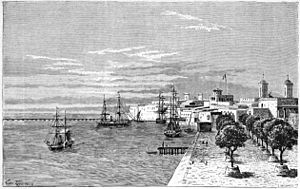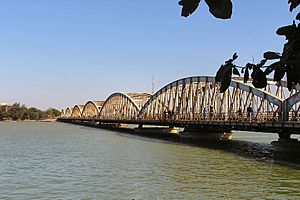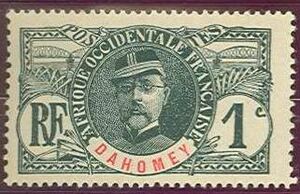Louis Faidherbe facts for kids
Quick facts for kids
Louis Faidherbe
|
|
|---|---|

Louis Léon César Faidherbe
|
|
| Born | 3 June 1818 Lille, France |
| Died | 29 September 1889 (aged 71) Paris, France |
| Allegiance | |
| Service/ |
French Army |
| Years of service | 1840–1879 |
| Rank | Général de Division |
| Commands held | Army of the North |
| Battles/wars | Franco-Prussian War |
| Awards | Grand Cross of the Légion d'honneur |
| Other work | Governor of Senegal Deputy of the National Assembly |
Louis Léon César Faidherbe (born June 3, 1818 – died September 29, 1889) was a French general and a leader in French colonies. He is famous for creating the Senegalese Tirailleurs, a group of soldiers from Senegal, when he was the governor of Senegal.
Contents
Early Life and Military Training
Louis Faidherbe was born in Lille, France, into a family that was not very rich. His father passed away when Louis was only seven years old, and his mother raised him.
He went to special military schools, first the École Polytechnique and then the École d'Application in Metz. After finishing his studies, he served as a soldier in Algeria and Guadeloupe for several years.
Leading in West Africa
In 1852, Faidherbe was sent to Senegal to work as an engineer. By 1854, he was promoted and became the governor of the colony. He stayed in this important role for most of the time until 1865.
His work in French West Africa is what he is most remembered for. When he arrived, France only controlled a small town called Saint-Louis and a narrow strip of land along the coast of Senegal.
Faidherbe had big plans. He wanted to expand French control into the rich areas near the Niger River. He even dreamed of creating a large French empire in Africa, stretching all the way to the Red Sea.
Taking Control of the Senegal River
Faidherbe's actions were part of a plan from the French government. This plan came from requests by a powerful trading company in Bordeaux. The company wanted to build forts along the Sénégal River. This would help France control the trade of acacia gum from the interior.
Faidherbe quickly started building these forts. One of the first was at Médine in 1855. By 1860, he had built many forts between Médine and Saint-Louis. He also sent soldiers to fight against the Trarza Moors who were collecting taxes on goods.
Conflicts with Local Kingdoms
Before Faidherbe, French forces usually avoided fighting strong local states like the Toucouleur Empire and Cayor. But Faidherbe began signing agreements with weaker states. This led to direct conflicts with the more powerful kingdoms.
War with the Toucouleur Empire
To achieve his goals, Faidherbe had limited resources. He faced strong opposition from Umar Tall, a powerful Muslim ruler. Faidherbe pushed French outposts further up the Senegal River. He also successfully defended the siege of Medina Fort against Umar Tall's forces.
In 1860, Faidherbe signed an important agreement with Umar Tall. This agreement connected the French lands with the Niger River. He also brought the land between the Senegal river and Gambia under French control.
War with the Serer People
In 1859, Faidherbe started a war against the Serer people of Sine. This happened during the rule of their king, Maad a Sinig Kumba Ndoffene Famak Joof. After winning the battle, Faidherbe ordered the town of Fatick and nearby villages to be burned.
The French government in Paris was not happy because Faidherbe started this war without their permission. Faidherbe claimed he was only taking back areas that France had owned since 1679. However, historians say that Faidherbe was making his own political decisions. The Kingdom of Sine had never belonged to France.
Economic Changes
Faidherbe made Saint-Louis a military-controlled area. He also set up telegraph and road links to other French colonies like Gorée Island and Rufisque. In 1857, the French took control of the area between these two places and renamed its capital Dakar.
Work began on the Dakar–Saint-Louis railway, and another rail line was planned along the Senegal River into the interior.
Faidherbe also started large projects like building bridges and providing fresh water. However, Saint-Louis's importance as a trading port began to decrease. This was because steamships found its port difficult to access. Also, the completion of the Dakar-Saint Louis railroad in 1885 meant that trade from inland areas bypassed Saint-Louis.
Large French companies took over the new trade routes. This pushed out the local traders who had managed trade before.
Faidherbe also encouraged large-scale farming of groundnuts near the forts and along the new rail lines. This created a system called "navétanes," where people moved to work seasonally. This system spread throughout French West Africa for many years.
Faidherbe's Legacy in Colonialism
When Faidherbe left his position, French rule was firmly established over a large and fertile area. He laid the groundwork for France's strong position in West Africa after 1904.
Historians say that Faidherbe's ideas helped shape French colonialism in Senegal. He made Senegal the main French base and focused on expanding French control inland.
Later Military Career
In 1863, Faidherbe became a general. He served in Algeria again from 1867 to 1870. When the Franco-Prussian War began, he was leading a division in Constantine, Algeria.
After France's army was defeated by the Prussian Army in 1870, Faidherbe and other colonial officers were called back to France. They were given higher ranks to lead new units. Faidherbe was promoted to divisional general in November 1870. In December, he became the commander-in-chief of the Army of the North.
Faidherbe quickly showed he was one of the most skilled generals fighting the Prussians. He won several small battles against the Prussian First Army. However, his army was made of new recruits and faced many problems like lack of supplies and low morale in the cold winter.
Faidherbe's army fought well by attacking isolated enemy forces and then retreating. But he was ordered to attack the Prussians in a large battle at St Quentin, where his army was defeated.
Political Life and Retirement

During his military career, Faidherbe received many honors, including the highest award, the Grand Cross of the Legion of Honor.
After the war, Faidherbe was elected to the French legislature in 1871. He chose to represent the Nord department. However, he resigned later that year because he disagreed with how the Assembly was creating a constitution.
Between 1871 and 1872, Faidherbe went on a scientific trip to Upper Egypt. He studied ancient monuments and writings there. He also visited Jerusalem and Italy.
In 1879, Faidherbe was elected to the French Senate for the Nord department. He resigned from his seat before his term ended in 1888.
Faidherbe was very interested in geography, history, languages, and archaeology. He wrote many books on these subjects. His works included studies on ancient writings, the French army's campaigns, and different African languages. He also wrote about the geography and history of Senegal and the Sahara.
Even when his health was failing, he continued to study his favorite topics.
Death
Louis Faidherbe passed away on September 29, 1889. He received a public funeral.
Statues and monuments were built in his memory in cities like Lille, Bapaume, Saint-Quentin, and Saint-Louis, Senegal. Many streets are named after him, as is a subway station in Paris, Faidherbe-Chaligny.
See also
 In Spanish: Louis Faidherbe para niños
In Spanish: Louis Faidherbe para niños






